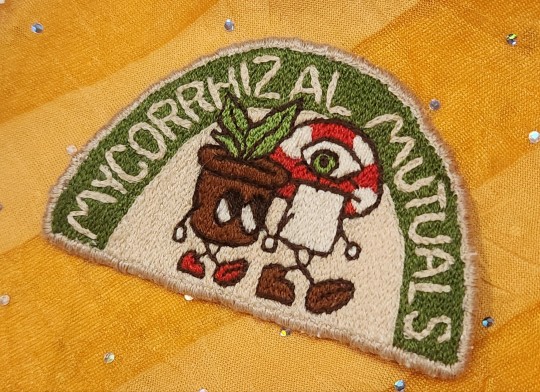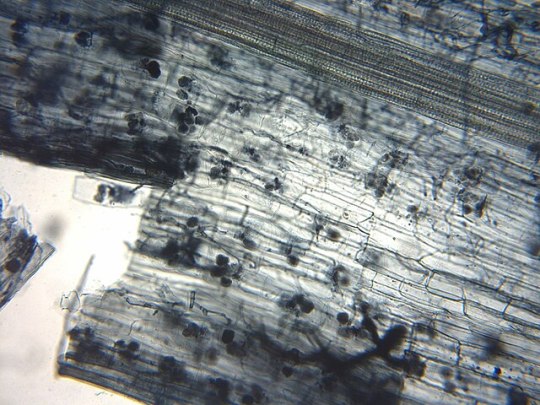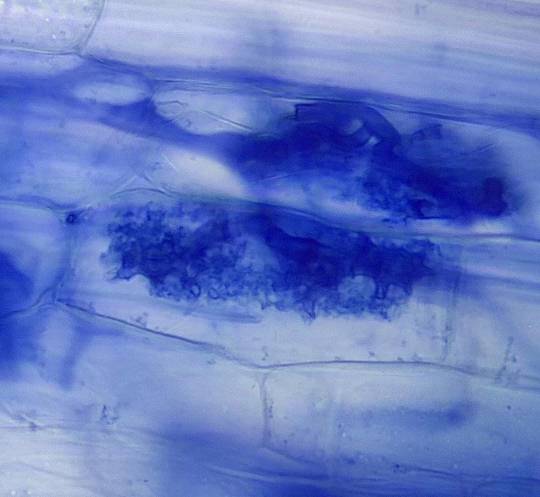#arbuscular mycorrhizal fungi
Text

Have you ever walked through an evergreen forest to clear your mind? Eaten a nice warm vegetable stew? Received flowers from someone you love? Well... thank our hidden hero:
Arbuscular Mycorrhizal Fungi!
Hidden beneath your feet, nestled away inside the roots of 80-90% of vascular plants, there is a complex network of hyphae working in tandem with their plant buddies to keep our ecosystems alive and thriving!
Essentially, these microscopic fungi give plants Super Tolerance. Hyphae are much smaller than roots, which means that they can reach out farther while expending less energy and worm their way into places that are normally inaccessible to plants. This allows vascular plants to access more mineral nutrients than they normally could on their own. These fun-guys are so effective that some plants can even live their lives completely achlorophyllic (without chlorophyll)!
In return, plants will partition some of the carbon and simple sugars produced from photosynthesis to give to their buddies. This is done through vesicles formed by hyphae in the plant cells.
This isn't anything new either! In fact, you might even thank AMF for plants migrating onto land at all. A popular hypothesis for the colonization of land by plants is that the first vascular plants formed from an ancient partnership between algae and fungi, where essentially the fungi would act as the algae's roots to collect nutrients not available to the algae alone outside the water. If you'd like to see a cool example, look up the Rhynie chert!!
Thank you for letting me ramble a while at you about my favorite organisms on this planet :•) I encourage all of you to do some more research on your own, there is a TON that I haven't covered here! If you have access to a microscope, you can even dissect and stain some common garden roots to say hello to these little buddies yourself!
[This piece is directly inspired by the work of @/byjacobparis on Instagram! Please go give him a follow :•) ]
#i think this is one of my favorite patches that ive done :•)#and YES they are gay#fungi#mycorrhizal fungi#arbuscular mycorrhizal fungi#plants#botany#mycology#mutualism#symbiosis#biology#embroidery#hand embroidery#patch#needlework#i should also note that they dont form fruiting bodies as far as im aware!!#the fly agaric on the patch is just an aesthetic choice lol
17 notes
·
View notes
Photo

The fate of the bean is in the hands of the fungus. By enhancing the Vicia faba's immunity against Rhizoctonia solani root rot diseases through the application of arbuscular mycorrhizal fungi and nano chitosan, the future of this legume is assured. The science of tomorrow is written in the soil.
0 notes
Text
Arbuscular mycorrhizal fungi develop, outside the root of their host, a highly branched system (mycelium) of hyphae (fine filamentous structures 2 to 10 μm in diameter) that explores the soil (Figure 5.12).

"Plant Physiology and Development" int'l 6e - Taiz, L., Zeiger, E., Møller, I.M., Murphy, A.
#book quote#plant physiology and development#nonfiction#textbook#arbuscular fungi#mycorrhizae#mycorrhizal network#fungus#symbiotic relationship#mycelium#soil science#plant growth#roots#glomus mosseae#cherry plum#prunus cerasifera
7 notes
·
View notes
Text
Why does everything I learn about trees feel so earth-shattering? I'm trying to look up stuff about mycorrhizal relationships and one of the types of mycorrhizal symbiosis is the arbuscular mycorrhizal symbiosis, or AM symbiosis for short.
Basically in these relationships, the fungus literally penetrates and grows into the plant cells, and the plant cells make tunnels in their walls so the fungus can do it. 70%-90% of all land plant species are known to do this.
That's the part I already knew about. What I didn't know is that we have fossils of completely identical-looking fungi in the fossils of the oldest land plants we know about.
8K notes
·
View notes
Text
What Are Lithophytes?

Originally posted on my website at https://rebeccalexa.com/what-are-lithophytes/
Ask most people what plants need to grow in, and they’ll say “soil” or “dirt”, right? And for the majority of terrestrial plants that’s the case. But given the sheer scale of biodiversity and the ability of species to make use of any niche–no matter how small–left unoccupied, there are of course exceptions. Take epiphytes, for example, that cling to the bark of trees and other plants. Rather than drawing nutrients and water from soil, they instead absorb what they need from the air. Psammophytes also get what they need from the air, but instead sink their root system into shifting sand dunes.
I am especially fascinated by lithophytes. “Litho-” means “stone”, and so a lithophyte is simply a plant that grows on stone. There are two main types of lithophyte. Epilithic lithophytes grow on a stone’s surface, and a crevice in the stone may be populated by endolithic lithophytes. Some of these plants can only grow on stone, so they’re described as obligate lithophytes, but their facultative lithophyte neighbors are those that are able to colonize both stone and soil or another substrate at the same time–some lithophytes can even live as tree-dwelling epiphytes instead!
Like epiphytes, a lithophyte may have some ability to absorb water and nutrients from the air. But they also capitalize on anything that ends up washed into their roots by rain. Endoliths may find that over time debris accumulating in their crevice offers a much-needed resource boost. As part or all of a lithophyte dies, the surrounding plants extract nutrients from the decaying matter–nothing goes to waste in nature, after all. They do not, as a general rule, have a negative effect on the rocks themselves; while some rock-dwelling lichens may chemically weather the stone beneath them, lithophytic plants simply use the rock as a convenient surface to take root.

Arbuscular mycorrhizae within a root as seen under a microscope
What I find really cool is that lithophytes can be mycorrhizal! Their roots are pierced by colonies of various arbuscular mycorrhizal fungi that draw up nutrients from the soil and share them with the plants. While this is a very common relationship in nature–four out of every five vascular plant species uses arbuscular mycorrhizal networks–lithophytes seem to have cultivated a greater concentration of these helpful fungi.
A moss-covered rock is often someone’s first encounter with lithophytes. Lacking proper roots, mosses hang onto the stone with tiny rhizomes. Over time they might cover its entire surface, and if said surface is relatively flat and protected from weather and other erosive forces, their decaying remains could be the very beginning of a new patch of soil.
But it’s not just the little bryophytes like mosses that can eke out a living on a rock. More complex vascular plants may also take root on or within stone. One of my favorite ferns, the licorice fern (Polypodium glycyrrhiza) commonly grows as an epiphyte on trees in the Pacific Northwest, but given the right opportunity it will colonize a suitable crevice in a cliff. Orchids may have a reputation for being difficult to care for in captivity, but in the wild there are a lot of lithophytic species. Many, like Dendrobium teretifolium or many Phalaenopsis species, can also live quite well as epiphytes on a tree or other plant. And the wallflower, Erysimum cheiri, got its common name for its tendency to grow out of cracks in rocky slopes.

Nepenthes campanulata
Unsurprisingly, some carnivorous plants make their homes on rocks, and their carnivory allows them access to much-needed nutrients in an otherwise limited setting. The pitcher plant Nepenthes campanulata often grows in colonies on cliff faces. Heliamphora exappendiculata, another pitcher plant, will happily grow both in wetlands and on constantly damp rocks. Sanderson’s bladderwort (Utricularia sandersonii) doesn’t eat insects, but instead sucks up microscopic organisms using bladders the plant buries under nearby soil or sediment.
One more thing: are the plants you see growing in gravel also lithophytes? Not necessarily. There may be soil beneath the gravel that the plant is exploiting. Or the gravel itself may be part of a mineral soil–one that has a lot of stone and not much organic material. A true lithophyte is going to be attached to a rock or rooted in its crevice, though it’s possible to find lithophytes growing on stones that, through weathering, may be feeding fragments into a nearby mineral soil over time.
Did you enjoy this post? Consider taking one of my online foraging and natural history classes or hiring me for a guided nature tour, checking out my other articles, or picking up a paperback or ebook I’ve written! You can even buy me a coffee here!
#lithophytes#botany#plants#science#nature#scicomm#carnivorous plants#moss#fungi#mycorrhizal fungi#mycology#ecology#bryophytes#biodiversity#epiphytes#educational
120 notes
·
View notes
Note
Hello! I see you use the word "mycorrhizal" often, what does it mean?
a "mycorrhiza" refers to a symbiotic relationship between fungi & green plants. a mycorrhizal association will occur when a fungus plays a role in a plant's root system.
"in a mycorrhizal association, the fungus colonizes the host plant's root tissues, either intracellularly as in arbuscular mycorrhizal fungi, or extracellularly as in ectomycorrhizal fungi. the association is normally mutualistic. in particular species, or in particular circumstances, mycorrhizae may have a parasitic association with host plants."
you can read more about it here (link) !! <3
21 notes
·
View notes
Text

Sketch of Cyphe! I just had my unit on mineralogy and wanted to do more earth genasi stuff. She’s based on agate, and her scars are opal.
And. Some fungi. She has a curse (chronic illness) and the necromancy is bringing out fungi, specifically glomeromycota, the arbuscular mycorrhizal fungi. Arbuscules form within the plant cell, the same thing is happening to her. These are based on fungi on agar plates.
#earth genasi#dnd art#character design#illustration#artists on tumblr#art#dnd#concept art#Cyphe#cyphelium evernia minarum nephrite#she’s a paleobotanist#a necromancer for plants!
27 notes
·
View notes
Note
I feel as if that begs the question -- what's your favorite fungus?
ok I left this in my inbox bc I wanted to give a proper answer but I'd probs have to say arbuscular mycorrhizal fungi! they don't form mushrooms or anything not visible w a microscope, but they live inside plant roots and provide plants w nutrients (in exchange for the plant feeding them as well!).
they're thought to be as old as plants themselves and you get them in around 80% of plant species and they're super important for ecosystems n stuff :) their biology as fungi is also really weird but I won't get into that
they also look rly cool under the microscope - they form these lil tree like structures (called arbuscules, which is latin for "little tree") in plant cells so they can exchange things w the plant :) here's a pic I took of 1 a while ago - they look blue because u have to treat the roots w a blue stain that makes the fungus visible

(I've considered making a biology sideblog for a bit idk - I kind of want an excuse to post about fun lil plant/microbial guys!)
6 notes
·
View notes
Text
arbuscular mycorrhizal fungi greg will see red sequoia tom and say ‘is anyone going to exchange nutrients with this tree in order to improve its growth and stress resistance’ and not wait for an answer
86 notes
·
View notes
Text
You dont have to lose pavements to grow trees in cities
You don’t have to lose pavements to grow trees in cities
https://ift.tt/JYseDm6
A recent study by Arianna Grassi and colleagues, published in Urban Forestry & Urban Greening, investigated the impact of different types of soil sealing on the communities of arbuscular mycorrhizal fungi colonising the roots of two shade trees commonly found in urban areas: Celtis australis and Fraxinus ornus. The researchers found that impermeable pavements, such as monolithic asphalt, caused shifts in the composition of arbuscular mycorrhizal fungal communities associated with the roots of these trees and impacted the percentage of mycorrhizal root length.
The research could help protect trees in urban environments. The soil beneath our feet is home to a vast and intricate web of organisms, including arbuscular mycorrhizal fungi (AMF), which form a symbiotic relationship with plant roots. These fungi play a crucial role in plant nutrition and health, enhancing their ability to absorb nutrients and water from the soil. Unfortunately, urbanisation and impermeable pavement materials have led to soil sealing, disrupting this vital ecosystem.
In their article, Grassi and colleagues cite research showing that Tilia, Linden or Lime trees suffer in areas with low fungal diversity. The authors state: “To the best of our knowledge, no information is available about the effects of pavements suitable for water sensitive urban designs, such as permeable and porous pavements, on AMF communities actually colonizing the roots of shade trees.”
Grassi and colleagues tackled the problem by examining the roots of European Hackberry and South European Flowering Ash growing in Vertemate con Minoprio, a little way north of Milan in Italy. The trees were planted in 2012, and in 2020, the pavements over the trees were removed. That allowed the biologists to take root samples from the trees and see what fungi had colonised them.
Grassi and colleagues observed a fungi community similar to the fungi in the unpaved soil when the root zone was covered with permeable pavements. This provides valuable information that can be used to reduce the disturbance caused by specific types of soil sealing on AMF symbionts, ultimately benefiting urban tree health.
The study identified 45 different types of arbuscular mycorrhizal fungi, with Sclerocystis and Septoglomus as the most abundant phylotypes, accounting for 84% of the genetic sequences revealed. The predominance of Sclerocystis species in the roots of both tree species under impermeable pavements indicated their high and unexpected tolerance towards harsh environmental conditions. These species could be used as arbuscular mycorrhizal fungal inocula. Inoculating the soil with these fungi, specifically selected for their proven resilience in paved sites, would allow planners to exploit their ability to boost biogeochemical processes fundamental for energy fluxes and plant nutrition and health.
By revealing how different pavements impact the fungi that symbiotically nourish trees, this study provides guidance for creating urban infrastructure that fosters tree health and longevity. Permeable pavements, in particular, could help sustain diverse, robust fungal communities essential for supporting trees in the often challenging conditions of cities. With more trees, cities can enjoy cooling, pollution reduction, and other benefits these fungi-tree partnerships provide.
READ THE ARTICLE
Grassi, A., Pagliarani, I., Cristani, C., Palla, M., Fini, A., Comin, S., Frangi, P., Giovannetti, M., Turrini, A. and Agnolucci, M. (2023) “Effects of pavements on diversity and activity of mycorrhizal symbionts associated with urban trees,” Urban Forestry & Urban Greening, 83(127916), p. 127916. Available at: https://doi.org/10.1016/j.ufug.2023.127916.
The post You don’t have to lose pavements to grow trees in cities appeared first on Botany One.
via Botany One https://botany.one/
April 13, 2023 at 06:19PM
4 notes
·
View notes
Note
10 mushroom facts:
1. "Mushroom" is not a fungal genus name.
2. Mushroom is also not a fungal taxon, though there may be other genera for certain types of mushrooms.
3. A group of related organisms is called a phylum. "Fungi" and "mushrooms" are not groups.
4. It's not fungal in general.
5. I am not sure how to look this up, but "fungus" is probably not used in a zoological context.
6. The mycorrhizal types of fungus include the plants and fungi, and there are also hyphae types.
7. This is an incredibly boring fact.
8. "Basidiomycota" and "Ascomycota" also don't actually mean anything.
9. If you're wondering why "mushrooms" is plural, it used to be "mushroom of the day" and there was one of them each day.
10. A list of fungal genera is not a list of fungal groups, even if the fungal groups are the names of the fungal genera. "Fungi" (as in the plural, not as in "the fungi") are not fungal groups.
This all is interesting to me for many reasons I can't quite put into words, but I think I did not actually answer your question. I'm sure there are lots of "mushroom facts" out there about fungi, maybe I am just out of the loop.
My guess is that the answer to your question depends on the exact definition of "mushroom", and there's a lot of variation in how that definition is used. It's likely that some people say "mushrooms" to mean what I just said, but others use it to refer to all fungal organisms.
For fungal taxonomy this is often how you get into "the fungi" (I hope that's the technical term in taxonomy) like "arbuscular mycorrhizal fungi" and "mycorrhizal basidiomycota", but they actually refer to a subset of the fungal organisms.
Maybe this is the answer to your question and I just didn't get it.
11 notes
·
View notes
Text
Arbuscular Mycorrhizal
The evolution of mycorrhizal symbiosis is thought to be an important pathway that enabled the development of land plants 400 million years ago.
Arbuscular Mycorrhiza, AM fungi are symbiotic with 80% of terrestrial plants, helping plants to obtain long-distance water and nutrients and promoting plants to adapt to environmental changes. Arbuscular Mycorrhiza extends extra-root hyphae from the…
View On WordPress
0 notes
Text
The fungal partner in these arbuscular mycorrhizal associations belongs to the ancient phylum Glomeromycota, which has lost the ability to complete its life cycle outside the plant.
"Plant Physiology and Development" int'l 6e - Taiz, L., Zeiger, E., Møller, I.M., Murphy, A.
#book quote#plant physiology and development#nonfiction#textbook#fungus#arbuscular mycorrhizae#mycorrhizal network#mycorrhizal fungi#glomeromycota#life cycle
0 notes
Link
0 notes
Text
Genuinely just looked at pictures of Arbuscular Mycorrhizal Fungi for motivation.
#the fungi truly have consumed me#they are also AMFs if you are cool#Glomeromycota is the phylum#I love them dearly you should check them out#call me patient zero the way fungi have consumed my mind#fungus
0 notes